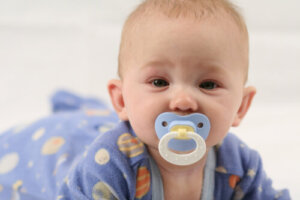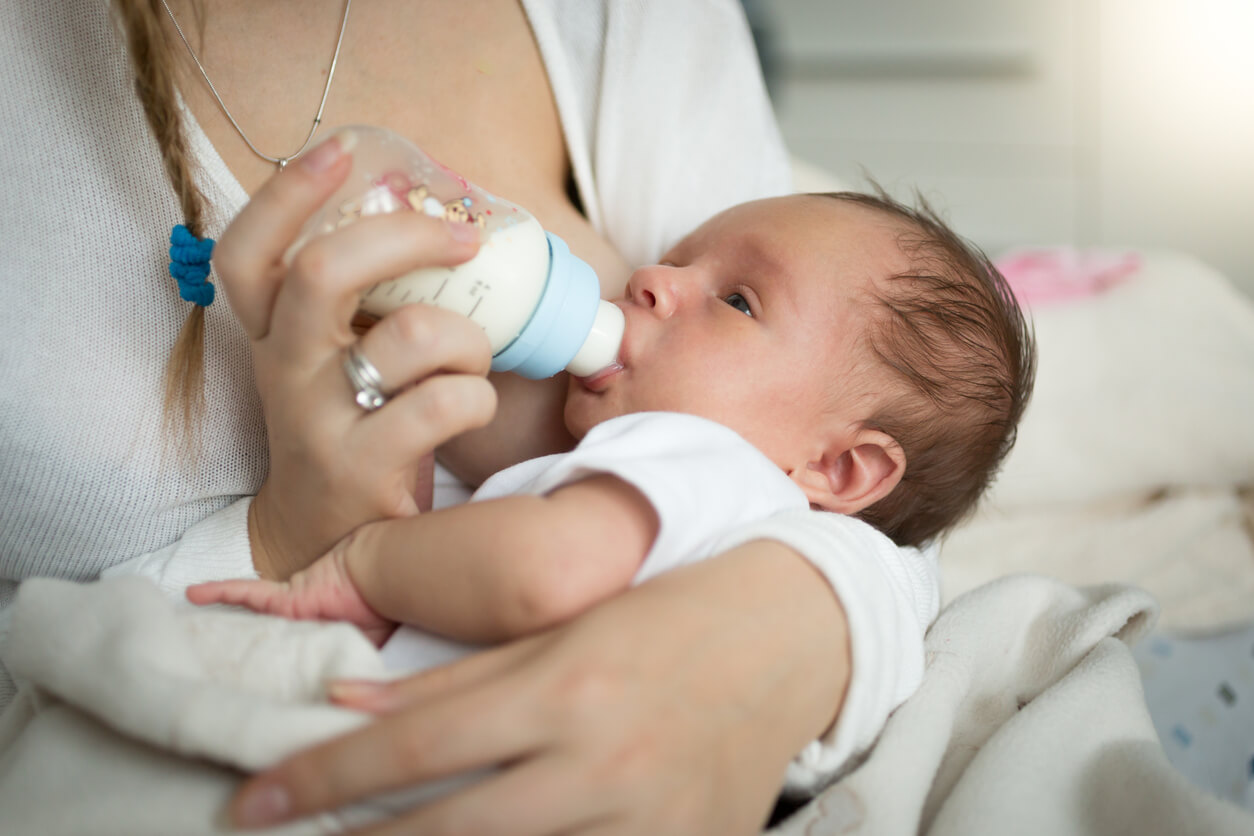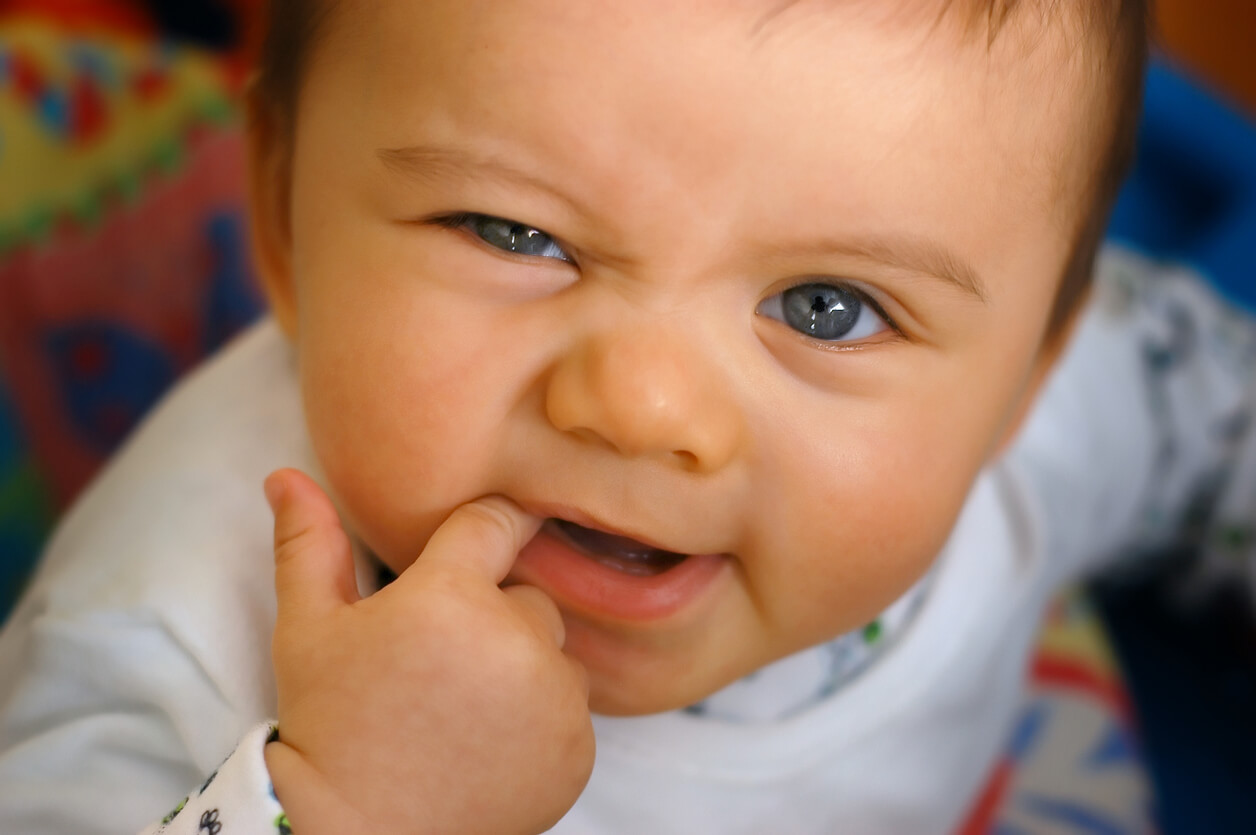Bottles and Pacifiers: How They Affect Oral Health


Written and verified by the dentist Vanesa Evangelina Buffa
Many of the habits in children’s early years impact their growth and development. The decision to use a pacifier or bottle for a baby is entirely up to the parents. Sometimes, these accessories bring benefits to the little one, but there are certain details that must be taken care of so that they don’t have negative effects on the mouth. Discover the relationship between the use of bottles and pacifiers and oral health.
Learn how the use of bottles and pacifiers affects children’s mouths
Many parents believe that the use of bottles and pacifiers is unnatural and harmful for babies. But the truth is that, in many situations, these elements bring benefits. Let’s take a look at both cases.
Pacifier use
Pacifiers can be a comforting and soothing item for babies while helping them fall asleep. For this reason, many parents offer them to their little ones. In addition, pacifiers help reduce the risk of sudden infant death syndrome. In turn, when using this element, little ones sleep less profoundly, which allows them to wake up more easily if they have episodes in which they stop breathing.
The use of bottles
Bottles are a tool that allows babies to feed when breastfeeding isn’t possible. This element, filled with pumped milk from the mother or with formulas, allows the baby to receive the nutrition it needs. It’s true that sucking during breastfeeding contributes to the better development of the jaws and prevents malocclusions and harmful habits, such as thumb sucking. But for some families, this practice isn’t possible, so they resort to using bottles.
On the other hand, babies have a strong sucking reflex and need to suckle in order to calm down and relax. For this reason, it’s common for them to resort to their own tongue or to bring their little hands to their mouth to calm this need.

How long to use these accessories
Therefore, the use of bottles and pacifiers in the first months of life provides benefits to children and doesn’t interfere with oral health. The problem with these elements is when their use is prolonged over time and becomes a habit. During infancy, the bones of the oral cavity and the face are in full growth and the teeth emerge and settle in the dental arches. Therefore, having an object in the mouth constantly interferes with the natural development of these structures and increases the risk of suffering oral problems.
The maximum age to use a pacifier without affecting oral health is 2 years old. Bottles, on the other hand, should disappear before 12 months of age. It’s always a good idea to start removing these objects before these ages. This way, it allows the baby to wean gradually and not in a rush when they turn one or two.
Consequences of prolonged use of bottles and pacifiers on oral health
If the use of these items is prolonged, it can cause some problems in the mouth and in the health of children. Below, we’ll tell you more in detail.
Difficulty in controlling tongue movements
When a child uses bottles and pacifiers regularly and for a long time, they get used to placing their tongue under the teat of these objects. As a result, the child swallows in this position, which can cause problems with feeding and speaking correctly. Keep in mind that when eating and swallowing solid foods, the physiological position of the tongue is to rest the tip on the palate.
Cavities in the baby’s teeth
When the first teeth appear in the mouth of children, they’re already susceptible to disease if they’re not properly cared for. In addition, the use of baby bottles, especially when they contain milk or sugary drinks, predisposes the teeth to develop cavities.
Bite problems
Prolonged and repetitive sucking on a bottle or pacifier can alter the normal development of the jaws and the positioning of the teeth. With this, it’s common for bite problems to appear, and orthodontic treatment is necessary to correct them.
During infancy, the bones of the mouth and face are in full growth, and teeth erupt and position themselves in the dental arches. If external factors interfere with these processes at this stage, oral development will be compromised. Diastemas, open bites, and class II occlusions are some of the most frequent disorders in children who prolong the use of these elements.

Ear infections
Pacifier use could be a risk factor for acute middle ear infections. This association is due to the fact that continuous sucking causes the tubes of the auditory system to be more open than usual. Thus, for example, during a common cold, germs can enter the auditory system more easily and cause infection.
Speech difficulties
The tongue plays a key role in the pronunciation of certain phonemes. Therefore, the lack of mastery of tongue movements causes speech problems in children. Moreover, in order to develop speech, children need to express themselves through babbling and vocal sounds. Consequently, the presence of bottles and pacifiers deprives little ones of having their oral cavity available to test their voice.
Recommendations so that bottles and pacifiers don’t affect oral health
There are some other practices that will allow you to take care of your baby’s mouth while using the pacifier and bottle. Take note of the following tips:
- Don’t offer bottles with milk at night or let the child fall asleep with the nipple in their mouth.
- Avoid sugar, cereals, and honey to sweeten the contents of the bottle or the nipple of pacifiers.
- Offer the pacifier after the child’s first month of life or once breastfeeding is well established.
- Avoid having the child use these accessories all the time.
- Choose a pacifier that is the right size and shape for the child’s mouth.
- The nipple of the bottle should have small holes that encourage the baby to suck.
- Discard the pacifier and bottle nipples as soon as you notice that they’re deteriorating or broken.
- Keep the pacifier and bottle clean and sterilized.
- Clean your baby’s teeth and gums properly and frequently.
- Visit a pediatric dentist before the baby’s first birthday.
Remove bottles and pacifiers in a timely manner
Removing pacifiers and bottles in a timely matter is the best way to avoid all the oral health problems we mentioned above. This way, it’s possible to take care of your child’s mouth and avoid problems in the future. It’s important to accompany the child with patience and a lot of love so that they can let go of these objects that have accompanied them.
Many of the habits in children’s early years impact their growth and development. The decision to use a pacifier or bottle for a baby is entirely up to the parents. Sometimes, these accessories bring benefits to the little one, but there are certain details that must be taken care of so that they don’t have negative effects on the mouth. Discover the relationship between the use of bottles and pacifiers and oral health.
Learn how the use of bottles and pacifiers affects children’s mouths
Many parents believe that the use of bottles and pacifiers is unnatural and harmful for babies. But the truth is that, in many situations, these elements bring benefits. Let’s take a look at both cases.
Pacifier use
Pacifiers can be a comforting and soothing item for babies while helping them fall asleep. For this reason, many parents offer them to their little ones. In addition, pacifiers help reduce the risk of sudden infant death syndrome. In turn, when using this element, little ones sleep less profoundly, which allows them to wake up more easily if they have episodes in which they stop breathing.
The use of bottles
Bottles are a tool that allows babies to feed when breastfeeding isn’t possible. This element, filled with pumped milk from the mother or with formulas, allows the baby to receive the nutrition it needs. It’s true that sucking during breastfeeding contributes to the better development of the jaws and prevents malocclusions and harmful habits, such as thumb sucking. But for some families, this practice isn’t possible, so they resort to using bottles.
On the other hand, babies have a strong sucking reflex and need to suckle in order to calm down and relax. For this reason, it’s common for them to resort to their own tongue or to bring their little hands to their mouth to calm this need.

How long to use these accessories
Therefore, the use of bottles and pacifiers in the first months of life provides benefits to children and doesn’t interfere with oral health. The problem with these elements is when their use is prolonged over time and becomes a habit. During infancy, the bones of the oral cavity and the face are in full growth and the teeth emerge and settle in the dental arches. Therefore, having an object in the mouth constantly interferes with the natural development of these structures and increases the risk of suffering oral problems.
The maximum age to use a pacifier without affecting oral health is 2 years old. Bottles, on the other hand, should disappear before 12 months of age. It’s always a good idea to start removing these objects before these ages. This way, it allows the baby to wean gradually and not in a rush when they turn one or two.
Consequences of prolonged use of bottles and pacifiers on oral health
If the use of these items is prolonged, it can cause some problems in the mouth and in the health of children. Below, we’ll tell you more in detail.
Difficulty in controlling tongue movements
When a child uses bottles and pacifiers regularly and for a long time, they get used to placing their tongue under the teat of these objects. As a result, the child swallows in this position, which can cause problems with feeding and speaking correctly. Keep in mind that when eating and swallowing solid foods, the physiological position of the tongue is to rest the tip on the palate.
Cavities in the baby’s teeth
When the first teeth appear in the mouth of children, they’re already susceptible to disease if they’re not properly cared for. In addition, the use of baby bottles, especially when they contain milk or sugary drinks, predisposes the teeth to develop cavities.
Bite problems
Prolonged and repetitive sucking on a bottle or pacifier can alter the normal development of the jaws and the positioning of the teeth. With this, it’s common for bite problems to appear, and orthodontic treatment is necessary to correct them.
During infancy, the bones of the mouth and face are in full growth, and teeth erupt and position themselves in the dental arches. If external factors interfere with these processes at this stage, oral development will be compromised. Diastemas, open bites, and class II occlusions are some of the most frequent disorders in children who prolong the use of these elements.

Ear infections
Pacifier use could be a risk factor for acute middle ear infections. This association is due to the fact that continuous sucking causes the tubes of the auditory system to be more open than usual. Thus, for example, during a common cold, germs can enter the auditory system more easily and cause infection.
Speech difficulties
The tongue plays a key role in the pronunciation of certain phonemes. Therefore, the lack of mastery of tongue movements causes speech problems in children. Moreover, in order to develop speech, children need to express themselves through babbling and vocal sounds. Consequently, the presence of bottles and pacifiers deprives little ones of having their oral cavity available to test their voice.
Recommendations so that bottles and pacifiers don’t affect oral health
There are some other practices that will allow you to take care of your baby’s mouth while using the pacifier and bottle. Take note of the following tips:
- Don’t offer bottles with milk at night or let the child fall asleep with the nipple in their mouth.
- Avoid sugar, cereals, and honey to sweeten the contents of the bottle or the nipple of pacifiers.
- Offer the pacifier after the child’s first month of life or once breastfeeding is well established.
- Avoid having the child use these accessories all the time.
- Choose a pacifier that is the right size and shape for the child’s mouth.
- The nipple of the bottle should have small holes that encourage the baby to suck.
- Discard the pacifier and bottle nipples as soon as you notice that they’re deteriorating or broken.
- Keep the pacifier and bottle clean and sterilized.
- Clean your baby’s teeth and gums properly and frequently.
- Visit a pediatric dentist before the baby’s first birthday.
Remove bottles and pacifiers in a timely manner
Removing pacifiers and bottles in a timely matter is the best way to avoid all the oral health problems we mentioned above. This way, it’s possible to take care of your child’s mouth and avoid problems in the future. It’s important to accompany the child with patience and a lot of love so that they can let go of these objects that have accompanied them.
All cited sources were thoroughly reviewed by our team to ensure their quality, reliability, currency, and validity. The bibliography of this article was considered reliable and of academic or scientific accuracy.
- Donelli, M. V., Latife, N. Y. C., Sal, J. N., & Antacle, A. A. (2021). Chupete: más que un calmante. Evidencia, actualizacion en la práctica ambulatoria, 24(3), e006940-e006940.
- Diaz Coronado, V. N. (2018). EFICACIA DEL USO DEL CHUPETE EN LA DISMINUCIÓN DE LA MUERTE SÚBITA EN LACTANTES.
- Illescas, M. V. L., Soto, A. R., & González, B. G. (2019). Maloclusiones dentarias y su relación con los hábitos bucales lesivos. Revista Cubana de Estomatología, 56(2), 1-14.
- Regueiro, B. P., Santos, G. G., & Perez, M. D. (2022). Lactancia artificial prolongada asociada a hábitos orales, maloclusiones y características sociodemográficas en preescolares españoles: Estudio observacional. Revista Española de Nutrición Humana y Dietética, 26.
- Rosas Lizarazo, G. L., Carmona, R., & Piedad, E. (2020). Asociación entre la maloclusión y los malos hábitos orales en niño de 3 a 12 años.
- Tamara, C., & Isabel, M. (2002). Uso seguro del chupete y otitis media aguda infantil. Community Nurs, 7(4), 208-211.
- Sánchez, L. M., González, E. D., Florensa, S. G. T., & Marti, J. G. (2000, January). Uso del chupete: beneficios y riesgos. In Anales de Pediatría (Vol. 53, No. 6, pp. 580-585). Elsevier Doyma.
- Mena Tudela, D., & Sánchez Reolid, J. (2019). Uso del chupete y efectos sobre la salud: una revisión de la literatura.
This text is provided for informational purposes only and does not replace consultation with a professional. If in doubt, consult your specialist.








